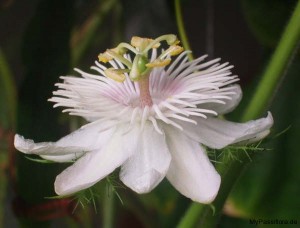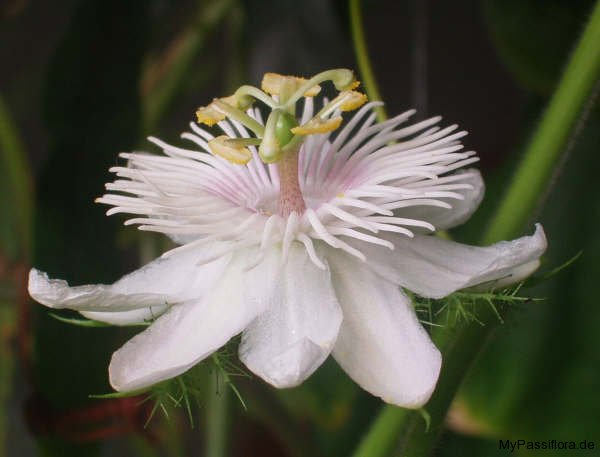 Passiflora foetida, das ist die stinkende Passionsblume (lateinisch foedidus = stinkend). Viele empfinden diesen Namen als passend, denn ohne Zweifel hat die foetida einen intensiven und eigentümlichen Geruch. Besonders stark riecht sie, wenn man ihre behaarten Blätter oder Stiele vorsichtig zwischen den Fingern reibt. Aber über Geschmack und Geruch kann man nicht streiten, heißt es zurecht. Denn für meine Nase riecht die Passiflora foetida lecker nach frischer Gurke, und ich liebe ihren Geruch!
Passiflora foetida, das ist die stinkende Passionsblume (lateinisch foedidus = stinkend). Viele empfinden diesen Namen als passend, denn ohne Zweifel hat die foetida einen intensiven und eigentümlichen Geruch. Besonders stark riecht sie, wenn man ihre behaarten Blätter oder Stiele vorsichtig zwischen den Fingern reibt. Aber über Geschmack und Geruch kann man nicht streiten, heißt es zurecht. Denn für meine Nase riecht die Passiflora foetida lecker nach frischer Gurke, und ich liebe ihren Geruch!
Die stinkende Passionsblume ist ganz flauschig!
Doch Passiflora foetida ist nicht nur für den Geruchssinn ein Erlebnis. Auch für den Tastsinn hat sie etwas zu bieten. Denn alle Teile der Pflanze sind von feinen, weichen Haaren umhüllt, so dass die Blätter sich ganz flauschig anfühlen.
Optisch fallen die weißen, ebenfalls von einem Geflecht aus haarigen Fasern geschützten Blüten auf, mehr noch aber ihre in reifem Zustand leuchtend orangefarbenen Früchte, die sie zahleich durch Selbstbestäubung bildet. Sie zieren die Pflanze den ganzen Winter über, wenn sie nicht abgeerntet werden, und trocknen über die Monate so weit aus, dass man im Frühjahr die Samen herausschütteln kann.
Bis auf die Tatsache, dass in einem Jahr, ich glaube 2008, keine einzige meiner Passiflora foetida-Pflanzen geblüht hat, erwies sich diese Passionsblumen-Sorte bei mir immer als ausgesprochen blühfreudig. Auch ist sie äußerst wüchsig und wuchert innerhalb weniger Wochen ihre nähere Umgebung vollständig zu. Mit ihrem Wachstumstempo kann kaum eine andere Passi mithalten.The stinking Passion Flower is fluffy!
Passiflora foetida, this means the stinking Passiong Flower (Latin foedidus = stinking).
Many people find this name appropriate, as P. foetida really does have an intensive and special smell. Especially you can smell it when softly rubbing the leaves or stems between your fingers. But There’s no accounting for taste. To my nose, Passiflora foetida smells of cucumber, and I just love its smell!
But Passiflora foetida is not only an experience for olfaction but it also offers an incentive for the sense of touch. All parts of the plant are covered by soft, fine hairs. This makes it feel fluffy.
Optically, the white flowers with bracts covered by a meshwork of hairs, attract attention but even more the fruits of P. foetida. The ripe fruits are colored bright orange and are produced in large quantities by self-pollution. They adorn the plant for many months or even through the winter if not harvested. In the springtime, they will be completely dry, so you can easily shake off the seeds.
Except from the fact that in one year, I think it was around 2008, not one single of my Passiflora foetida plants bloomed, this species has always been very floriferous. It also grows extremely fast. Within a few weeks time, it overgrows all other plants, because hardly any Passi can keep up with it.

Tolle Informationen! Ich werde mich damit mal genauer auseinander setzen! Warte auf neue Posts!